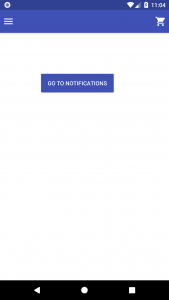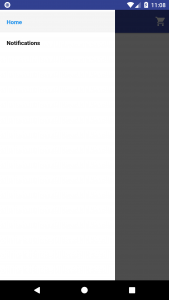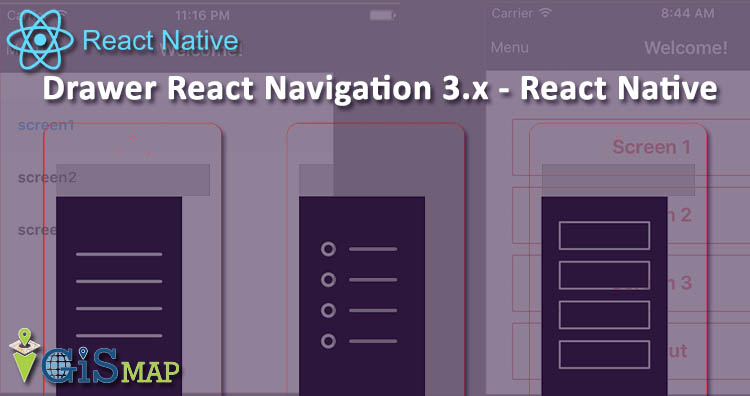Drawer React Navigation 3.x – react native: In this post we are going to learn about drawer navigation of React Navigation 3.x with one example,, but before going to detail of this article I suggest you to read the official documentation of React navigation 3.x as follow:
Drawer React Navigation 3.x – react native
In the below example we are going to learn basics of drawer and how to implement it in our application.
Installation :
First create a react native project by following command :
react-native init MyProject
Install the react-navigation package in your React Native project.
cd MyProject npm install --save react-navigation # or with yarn # yarn add react-navigation
install react-native-gesture-handler :
npm install --save react-native-gesture-handler # or with yarn # yarn add react-native-gesture-handler
Link all native dependencies:
react-native link
After all this my project’s package.json file is as follow:
{
"name": "MyProject",
"version": "0.0.1",
"private": true,
"scripts": {
"start": "node node_modules/react-native/local-cli/cli.js start",
"test": "jest"
},
"dependencies": {
"react": "16.6.1",
"react-native": "0.57.7",
"react-native-gesture-handler": "^1.0.10",
"react-navigation": "^3.0.5"
},
"devDependencies": {
"babel-jest": "23.6.0",
"jest": "23.6.0",
"metro-react-native-babel-preset": "0.50.0",
"react-test-renderer": "16.6.1"
},
"jest": {
"preset": "react-native"
}
}In our Project we are having two java script file as follow:
- index.js
- App.js
index.js :
import {AppRegistry} from 'react-native';
import App from './App';
import {name as appName} from './app.json';
AppRegistry.registerComponent(appName, () => App);App.js :
import React, { Component } from 'react';
import { View } from 'react-native';
import { createDrawerNavigator,createAppContainer } from 'react-navigation'
import { Button,Container,Header,Left,Right,Icon,Text } from 'native-base';
class MyHomeScreen extends React.Component {
render() {
return (
<Container>
<Header>
<Left style={{ flexDirection: 'row'}}>
<Icon onPress={() => this.props.navigation.openDrawer()} name="md-menu" style={{ color: 'white', marginRight: 15 }} />
</Left>
<Right>
<Icon name="md-cart" style={{ color: 'white' }} />
</Right>
</Header>
<View style={{ marginTop:100,marginLeft:100}}>
<Button onPress={() => this.props.navigation.navigate('Notifications')} >
<Text>Go to notifications</Text>
</Button>
</View>
</Container>
);
}
}// End of MyHomeScreen class
class MyNotificationsScreen extends React.Component {
render() {
return (
<View style={{ marginTop:100,marginLeft:100}}>
<Button onPress={() => this.props.navigation.goBack()} >
<Text>Go back home</Text>
</Button>
</View>
);
}
}//End of MyNotificationsScreen class
const MyDrawerNavigator = createDrawerNavigator({
Home:{
screen: MyHomeScreen,
},
Notifications: {
screen: MyNotificationsScreen,
},
});
const MyApp = createAppContainer(MyDrawerNavigator);
class App extends React.Component{
render(){
return(
<Container>
<MyApp >
</MyApp >
</Container>
);
}
}//End of App class
export default App;
In above code of App.js file we have used component of native base ,and therefore we will install native base as follow :
Install NativeBase
npm install native-base --save
Install Peer Dependencies
react-native link
Explaination of App.js :
In this file App.js, we have define three class namely as follow:
- MyHomeScreen
- MyNotificationsScreen
- App
and two constants as follow:
- MyDrawerNavigator
- MyApp
We are creating two screen with the help of two class MyHomeScreen and MyNotificationsScreen
class MyHomeScreen :
class MyHomeScreen extends React.Component {
render() {
return (
<Container>
<Header>
<Left style={{ flexDirection: 'row' }}>
<Icon onPress={() => this.props.navigation.openDrawer()} name="md-menu" style={{ color: 'white', marginRight: 15 }} />
</Left>
<Right>
<Icon name="md-cart" style={{ color: 'white' }} />
</Right>
</Header>
<View style={{ marginTop:100,marginLeft:100}}>
<Button onPress={() => this.props.navigation.navigate('Notifications')} >
<Text>Go to notifications</Text>
</Button>
</View>
</Container>
);
}
}// End of MyHomeScreen classExplaination of MyHomeScreen class :
In this class we are creating header of screen ,on left side of header we are creating Icon of “md-menu”,and onPress of this Icon we have open the drawer with the help of this code :
onPress={() => this.props.navigation.openDrawer()}In this home screen one button is also given ,on press of this button MyNotificationsScreen is called with following code :
onPress={() => this.props.navigation.navigate('Notifications')}
class MyNotificationsScreen :
class MyNotificationsScreen extends React.Component {
render() {
return (
<View style={{ marginTop:100,marginLeft:100}}>
<Button onPress={() => this.props.navigation.goBack()} >
<Text>Go back home</Text>
</Button>
</View>
);
}
}//End of MyNotificationsScreen classExplaination of MyNotificationsScreen class :
In this class we are creating a button ,and on press of this button we are going back to home screen from this notification screen ,for this we are using following code:
onPress={() => this.props.navigation.goBack()}Constant MyDrawerNavigator :
const MyDrawerNavigator = createDrawerNavigator({
Home: {
screen: MyHomeScreen,
},
Notifications: {
screen: MyNotificationsScreen,
},
});Constant MyApp :
const MyApp = createAppContainer(MyDrawerNavigator);
Class App :
class App extends React.Component{
render(){
return(
<Container>
<MyApp />
</Container>
);
}
}Explaination of App class:
In this class we are using <MyApp /> tag .
When you will run the above code, following output will come

On Left side of Header we are having menu ,on press of this drawer will be open as follow:

If you face any problem during implementing this tutorial, please let us know. Feel free to comment in given comment box.
You might be interested React Native Geolocation
